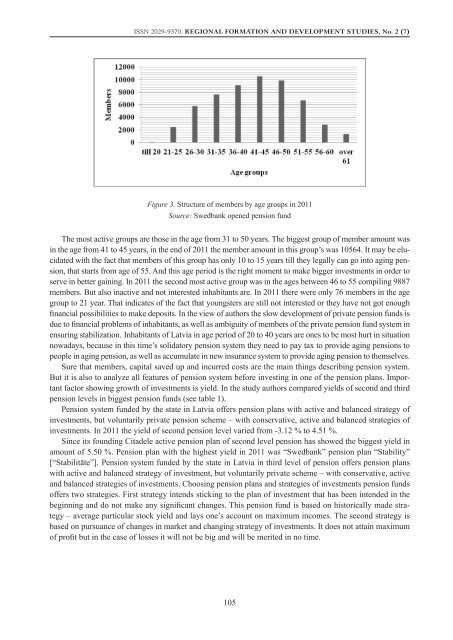regional formation and development studies - KlaipÄdos universitetas
regional formation and development studies - KlaipÄdos universitetas
regional formation and development studies - KlaipÄdos universitetas
You also want an ePaper? Increase the reach of your titles
YUMPU automatically turns print PDFs into web optimized ePapers that Google loves.
ISSN 2029-9370. Regional Formation <strong>and</strong> Development Studies, No. 2 (7)<br />
Figure 3. Structure of members by age groups in 2011<br />
Source: Swedbank opened pension fund<br />
The most active groups are those in the age from 31 to 50 years. The biggest group of member amount was<br />
in the age from 41 to 45 years, in the end of 2011 the member amount in this group’s was 10564. It may be elucidated<br />
with the fact that members of this group has only 10 to 15 years till they legally can go into aging pension,<br />
that starts from age of 55. And this age period is the right moment to make bigger investments in order to<br />
serve in better gaining. In 2011 the second most active group was in the ages between 46 to 55 compiling 9887<br />
members. But also inactive <strong>and</strong> not interested inhabitants are. In 2011 there were only 76 members in the age<br />
group to 21 year. That indicates of the fact that youngsters are still not interested or they have not got enough<br />
financial possibilities to make deposits. In the view of authors the slow <strong>development</strong> of private pension funds is<br />
due to financial problems of inhabitants, as well as ambiguity of members of the private pension fund system in<br />
ensuring stabilization. Inhabitants of Latvia in age period of 20 to 40 years are ones to be most hurt in situation<br />
nowadays, because in this time’s solidatory pension system they need to pay tax to provide aging pensions to<br />
people in aging pension, as well as accumulate in new insurance system to provide aging pension to themselves.<br />
Sure that members, capital saved up <strong>and</strong> incurred costs are the main things describing pension system.<br />
But it is also to analyze all features of pension system before investing in one of the pension plans. Important<br />
factor showing growth of investments is yield. In the study authors compared yields of second <strong>and</strong> third<br />
pension levels in biggest pension funds (see table 1).<br />
Pension system funded by the state in Latvia offers pension plans with active <strong>and</strong> balanced strategy of<br />
investments, but voluntarily private pension scheme – with conservative, active <strong>and</strong> balanced strategies of<br />
investments. In 2011 the yield of second pension level varied from -3.12 % to 4.51 %.<br />
Since its founding Citadele active pension plan of second level pension has showed the biggest yield in<br />
amount of 5.50 %. Pension plan with the highest yield in 2011 was “Swedbank” pension plan “Stability”<br />
[“Stabilitāte”]. Pension system funded by the state in Latvia in third level of pension offers pension plans<br />
with active <strong>and</strong> balanced strategy of investment, but voluntarily private scheme – with conservative, active<br />
<strong>and</strong> balanced strategies of investments. Choosing pension plans <strong>and</strong> strategies of investments pension funds<br />
offers two strategies. First strategy intends sticking to the plan of investment that has been intended in the<br />
beginning <strong>and</strong> do not make any significant changes. This pension fund is based on historically made strategy<br />
– average particular stock yield <strong>and</strong> lays one’s account on maximum incomes. The second strategy is<br />
based on pursuance of changes in market <strong>and</strong> changing strategy of investments. It does not attain maximum<br />
of profit but in the case of losses it will not be big <strong>and</strong> will be merited in no time.<br />
105

















